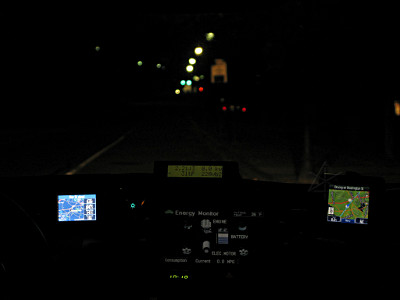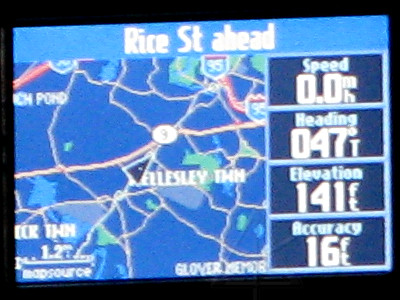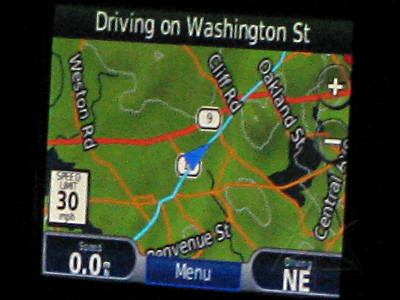I've been sadly disappointed, despite giving it the old school try in a number of ways including actually buying the "gift" Nuvi 500 [on sale at REI!] and aiming to preconfigure it and learn enough to better coach its eventual recipient. By now I'm a reasonably seasoned GPS user and understand the common aspects behind how all of them work, so this discussion comes from an experienced viewpoint. I already had the idea that the Nuvi line was a bit more dumbed-down, but I had no idea of the extremes Garmin seems to have recently gone to in talking down to their customer base. One has to wonder if they've "downsized" all their good programmers right out the door and outsourced subsequent efforts to offshore fresh-out-of-CS-class codemonkeys who never really studied embedded programming, let alone any prior GPS interfaces.
One good method of shopping and doing product research is to read online user manuals. Garmin has always provided these freely on their website, but in looking through about any of the Nuvi manuals it is never made clear what software running on a computer is supposed to be used to interact with the Nuvi and transfer data back and forth. When I got my Quest, it included two CDs with the latest "Cityselect" NAVTEQ detail data and a copy of MapSource, their companion program for Windows, and all the stuff I'd need to set up and cross-load map data into the Quest. The Quest has somewhat limited memory, so it can't hold the entire country's map detail in one shot but I could load a respectable chunk of a given area. The assumption clearly was that the user *would* be interacting fairly heavily with a computer, so it was all included. The other great thing I rely on heavily is being able to pull my own travel tracks or "breadcrumb trail" off the unit and review routes, check elevations of interesting places, match times and places against picture EXIF data [such as for bad-trucker incident reports or "what town was that cool building in again?"], get accurate distances on MPG competition circuits, etc. Not to mention having backups of the data once the downloaded files get snapshotted to offline storage. It all feels like a nice integrated package that does what I need.
Evidently the importance of computer communication has diminished quite a bit or turned into useless fluff in Garmin's collective thinking, because the Nuvi comes with no software, no cable, and not even the full user manual in the box -- just a "quickstart" guide, in which NO mention whatsoever is made of using software of any sort. They seem to assume all users are just going to plunk it onto the dashboard and drive. But wait, when you try to access items like "geocaches" or "whereigo", the unit itself tells you that you first need to go visit some random websites with your computer. What's that all about, it's certainly not about downloading my hard-earned track from the day's roadtrip. Said third-party websites are of course going to tell you to download some software package and use it to communicate with the Nuvi, which now you can't do unless you have or get a mini-USB cable. How hard would it be to throw a cheap one into the box, guys? My Quest came with a fairly high-quality one, in fact. And it would be much more reassuring to get the software I need from the more trusted source of a physical distribution right there in with the unit, than have to go grope around the net for it.
I quickly found that my old windows-based Mapsource won't talk to this unit, which didn't surprise me a whole lot but reflects the typical short cycle of what the GPS world laughingly calls communications "standards". When the Nuvi is plugged into a USB port it immediately goes into "mass-storage" mode and renders itself otherwise completely unusable, and when the USB drive is ejected on the computer the Nuvi reboots and then goes right back *into* mass-storage mode if you don't unplug it quickly enough. What rocket scientist came up with that operational model? At least power off or do something to hold the finished state of the session the user just requested to end until the cable is actually unplugged. The Quest, although it doesn't do USB-storage mode, stays fully operational with the rest of the interface available whether it's talking to a PC or not. This is NOT one cue Garmin should have taken from some of the digital camera makers, and can only lead to problems because as people get annoyed with this and try to work around it, they're going to wind up yanking the connection to a USB filesystem that was attached READ/WRITE before it's fully synced and dismounted -- eventually screwing it up in some way and ending up with a nonbootable unit.
Ironically, the 12V car power cable also plugs into the teeny USB connector on the back of the unit, but does *not* make it go into mass-storage mode. I wonder what the exact electrical difference is?
I called the Garmin support line a couple of different times; first before making any purchase decisions just to get an idea on which units have which features, as there didn't seem to be a convenient one-page matrix of same. [Only later did I learn that *other* GPS-enthusiast sites maintain some nice feature charts of their own, but I hadn't gotten quite that far in the research process yet.] Turns out that Garmin has sort of a matrix too, but it's all Javascript-based muck and simply comes up blank in my usual no-nonsense browser setup. [Hello, anyone ever heard of standards-based HTML *tables*?? You're looking at one right now, in fact...] The next call was to basically ask "okay, now what?" in terms of software interaction once the unit was in hand, a call I'm sure they get pretty routinely because what comes with it certainly doesn't tell the buyer. It isn't made obvious from the website, either.
Calling Garmin is incredibly frustrating. Their IVR tells you right up front that you're going to wait on hold for 15 - 20 minutes, which never seems to vary. It's right. So why not, I asked them later in email, staff up the support call center appropriately especially with holidays looming on the horizon? They seem to feel that they don't owe the public anything. At one point one of my calls suddenly disconnected, either through phone system problems or representative error, with NO recourse but to wait another goddamn 20 minutes for a different person and start the discussion all over again. This is not the way to run a professional support organization, despite what seems to be a common problem around the industry. That's no excuse, and making it an excuse flags a company that has gotten way too big for its britches and lost sight of "customer care". And for the record, guys, nobody cares if your "menu options have changed", just present them as they are now without backpedaling.
It may help slightly to first give the finally-reached human a callback number and ask to be called back immediately in the event of disconnect. I suppose that could hold true for any other call center too, but many refuse to even do that much. Where lawyers and marketers will be the first ones up against the wall when it all comes down, support call-center managers will be a very close third.
While on one of the calls I asked about Mac support; the person said the equivalent of MapSource for the Mac is called "Roadtrip" but claims that it would refuse to run before you have maps loaded. Well, how does one go about that? What maps? Never made clear. I was already tired of bickering with these people, not to mention their flakey phone system and the cavalier waste of my time.
But back to the Nuvi vs. Quest comparo. The Nuvi 500 seemed the most sensible decision because it's designed to be fairly waterproof, and shows the best rated internal battery life of any of the new vehicle-oriented units by *double* -- 8 hours instead of 4 or less for all the rest, which seems strange. What's so different about the 500's power demand? A removable battery does allow for carrying fresh charged extras and swapping on a long off-road hike or whatever as needed. But even then, only 8 hours per under optimal conditions. The Quest was rated for something like 20 on an internal, non-removable battery -- what happened in the meantime to bring all the battery run-times down so drastically?
After setting the backlight less than retina-searing 100% and bringing the beep volume way down from full-blast, I could actually start poking around the interface and playing. One immediate problem is that the "restore" touchscreen-button is often too close to other options and easy to hit by mistake, offering to zorch all your work back to factory defaults. Or if the GPS receiver is off and the "set loc" button gets touched while moving around the static map, and boom, the position pip magically teleports to where you didn't want it to. Even after recalibration, the screen's touch matrix doesn't seem to be all that accurate, or the button areas insufficiently well defined to follow their image boundaries. There's no "dead" zone defined between active adjacent areas; being slightly off from one means selecting the next one over whether you like it or not. There are many arguments that a touchscreen is the wrong type of interface for anything in a car, too, since one has to look at the screen more often and cannot do things by learned feel. But most of the newer units have precisely one button -- for power, that's it. If everything else has to come through the screen, how about having an unlikely-by-accident sequence to LOCK out touches for when you're carrying it around? Any smartphone/PDA worth its salt can do that.
Confucius say:
Man with one GPS know where he is.
Man with two GPS have no fucking idea.

[Click for larger view]
I set the new one up temporarily in the car to compare various things for a couple of days while I ran around doing my normal activities. This is me pulled off to the side briefly while tooling through Wellesley MA to change some settings, and yes, while it's unintentional positioning on my part where I chose to stop, that is a cop up ahead pulled off even farther who's likely wondering what the heck I'm doing back here running around the car and leaning into the back hatch with a camera. But what he's probably there for is waiting in the shadows for the inevitable overprivileged and overpowered numbnuts blasting up this 30-MPH stretch at 50+ in the sixty-grand crossover-ute his parents gave him, which is all good. This *is* Wellesley after all, and it gets a lot of that.
Instead of fine-grained configurability on how mapping and routing is done that the Quest offers, letting you set up all your expected average speeds on different road types and setting "lock to road" or not, the Nuvi has this foggy concept of "usage modes" -- drive, walk, or bike, which in theory cause different behaviors but I cannot discern what's really changed and the manual doesn't offer anything more than the sketchiest "it's different" explanation. I vastly prefer the 2-D map with north up rather than the hokey 3-D "flying view" that's everybody's new default including the Nuvi; that's settable. In 2-D mode the Nuvi displays terrain shading and contour lines with elevations from the *database*, as opposed to the one derived from the sats -- it comes with a full topo-enabled database, which is a big point in its favor; the downside is that topo cannot be independently turned off when you don't need to see it. Oops. What's really missing is the ability to add custom data to the running map -- on the Quest, there are four fields off to the right that can be set up to read any of about 20 different parameters, one of which I value highly is elevation. No such luck on the Nuvi, although it makes a prominent point of displaying the relief shading and many more of the contour line elevations at the higher levels of map detail. No, that's not what I wanted; I and my running track-log want how high I am right *here*, not at the next contour line. The only place elevation seems to get interactively displayed is on the "compass" page, a total of *six* touch-strokes to reach it and then get back to the running map afterward. And I'm not sure if that figure is coming off the database or a best-guess from the sats as it does from the Quest.
You have to turn on track [aka what they now call "trip log"] to see it, stretching out behind the pip in what a GPS-forum posting calls "robins-egg blue", as opposed to the nice crisp tiny white dots on the Quest. Of course there's no configuration for it such as waypoint frequency or whether to stop recording when the memory is full or roll around to the beginning again. The only options concerning track in general are see it or not see it, and to clear it. Not as useful, and a little later I found out it doesn't even capture the observed elevation data like the Quest does.
But later I realized the Nuvi's true downfall with respect to the running map. It shows even *less* useful information, never mind the lack of configurable info boxes. Compare the closeups of the Quest and the Nuvi from the same Wellesley picture, on my return trip from a meeting [which is why the blue track also shows ahead of me]. Ignore picture quality here, this is about content:

